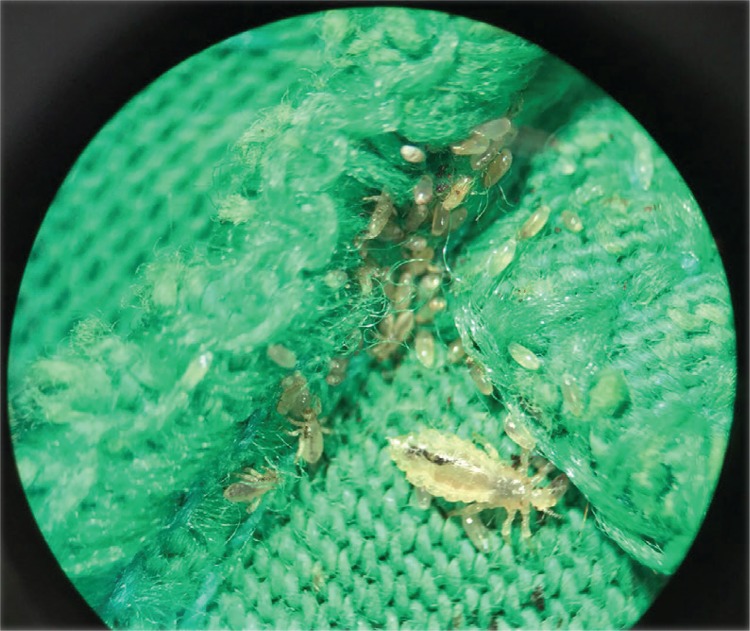Dear Editor
The Pediculus humanus humanus (body louse or Brazilian “muquirana”) has been causing infestations in vulnerable human populations with poor hygiene habits such as homeless, inmates and refugees 1 . P. h. humanus is the only of three lice species related to potentially lethal infectious diseases, recognized as a competent vector of Rickettsia prowazekii, Bartonella quintana and Borrelia recurrentis 2 . Recent data from Marseille, France (43°17'47"N 5°22'12"E) and Bogotá, Colombia (4°42'40"N 74°4'20"W) have described a decrease over time in overall body lice prevalence and have identified independent risk factors (older age, length of stay in France for migrants, frequent consumption of alcohol and tobacco smoking) for infestation among French homeless people 3 , alongside with 11.7% body lice prevalence in Colombian homeless 4 . Despite a Mediterranean climate in Marseille (14.5 ºC) and a subtropical highland climate in Bogotá (12 ºC), both cities provide similar mild average temperatures that favor body lice interaction with homeless people.
Based on these concomitant findings, we have first investigated body lice in a homeless of Curitiba (25°25'47"S, 49°16'19"W), the coldest and the eighth biggest Brazilian State capital (average temperature 16.5 ºC), with a similar subtropical highland climate in comparison with Bogotá. A homeless volunteer found in downtown square, presenting truncal pruritic and scratching lesions was examined. Lice were collected using forceps and identified as Pediculus humanus humanus (body lice) based on the recovery site (clothing). Due to this positive finding, similar survey was performed in a homeless shelter of downtown São Paulo (23°33'1"S, 46°38'2"W), the largest South American city, with humid subtropical climate and average temperatures varying from 19 °C (winter) to 25 ºC (summer).
Overall, several nits were evidenced in clothing seams with 10 (7 nymphs and 3 adults) body lice recovered in the Curitiba’s homeless and 57 (50 nymphs and 7 adults) in clothing from 2 out of 5 homeless examined in São Paulo (Figure 1).
Limited body lice records were described in Brazil, infesting clothes and bedding of three relatives living in precarious household conditions in a shantytown in São Paulo 5 , and a considerable infestation in a homeless person with abrasions and hyperchromic skin lesions 6 . Nevertheless, in this last report P.h. capitis may have been mistaken for P. h. humanus as specimens were collected in hairy body areas and not in clothes 5 .
Our preliminary findings confirmed the suspicious body lice circulation among homeless populations in major Brazilian cities, drawing attention to the diagnosis, control and prevention of body lice infestation in vulnerable populations of other tropical cities in Latin America, and suggesting that further investigation of potential associated diseases should be performed.
REFERENCES
- 1.Brouqui P, Raoul D. Arthropod-borne diseases in homeless. Ann N Y Acad Sci. 2006;1078:223–235. doi: 10.1196/annals.1374.041. [DOI] [PubMed] [Google Scholar]
- 2.Badiaga S, Raoult D, Brouqui P. Preventing and controlling emerging and reemerging transmissible diseases in the homeless. Emerg Infect Dis. 2008;14(9):1353. doi: 10.3201/eid1409.082042. [DOI] [PMC free article] [PubMed] [Google Scholar]
- 3.Ly TD, Touré Y, Calloix C, Badiaga S, Raoult D, Tissot-Dupont H, et al. Changing demographics and prevalence of body lice among homeless persons, Marseille, France. Emerg Infect Dis. 2017;23:1894–1897. doi: 10.3201/eid2311.170516. [DOI] [PMC free article] [PubMed] [Google Scholar]
- 4.Faccini-Martínez ÁA, Márquez AC, Bravo-Estupiñan DM, Calixto OJ, López-Castillo CA, Botero-García CA, et al. Bartonella quintana and typhus group rickettsiae exposure among homeless persons, Bogotá, Colombia. Emerg Infect Dis. 2017;23:1876–1879. doi: 10.3201/eid2311.170341. [DOI] [PMC free article] [PubMed] [Google Scholar]
- 5.Linardi PM, Soares Barata JM, Urbinatti PR, Souza D, Botelho JR, Maria M. Infestação por Pediculus humanus (Anoplura: Pediculidae) no Município de São Paulo, SP, Brasil. Rev Saude Publica. 1998;32:77–81. doi: 10.1590/s0034-89101998000100012. [DOI] [PubMed] [Google Scholar]
- 6.Martins LG, Bernardes F, Filho, Quaresma MV, Bellott TR, Botelho LN, Prata AC. Dermoscopy applied to pediculosis corporis diagnosis. An Bras Dermatol. 2014;89:513–514. doi: 10.1590/abd1806-4841.20142654. [DOI] [PMC free article] [PubMed] [Google Scholar]



